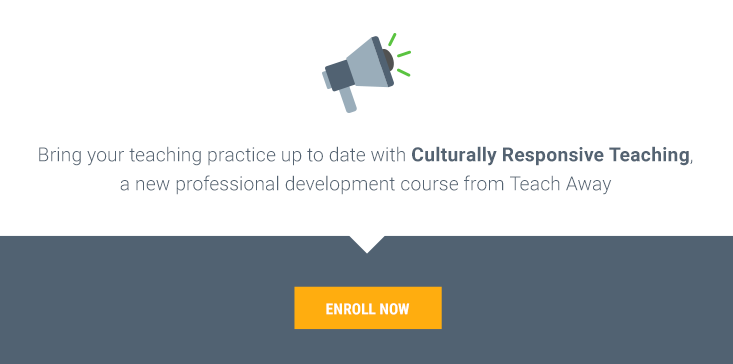What is culturally responsive teaching?
It’s much more than just recognizing your students’ cultural background (although that’s a good start).
Culturally responsive teaching, or cultural intelligence in education, helps create a learning environment that is engaging and accessible to a broader range of students.
As a teacher in today’s multicultural classroom, fostering culturally responsive teaching practices is becoming more and more necessary.
The Census Bureau had projected that by 2020 more than half of all students in US public schools will be minority students.
Figuring out how to meet the diverse needs of students with differing economic and cultural backgrounds, not to mention varying learning styles, has become a top priority for educators.
Teachers need to have cultural knowledge. You should try to understand achievement gaps as well as cultural and linguistic differences.
Increasing your understanding will help you resolve potential cultural differences between students in the classroom.
To become a more culturally responsive teacher you should:
- Assess your own behavior.
- Get to know your students.
- Make your classroom a judgment-free zone.
- Adapt your teaching practices.
- Teach for all cultures.
1. Assess your own behavior.
It’s important to recognize that your own culture influences your attitudes.
Have you ever heard of implicit bias?
Implicit bias is the attitudes or stereotypes that affect someone’s understanding, actions, and decisions unconsciously. These are biases we are completely unaware of, so it’s important to learn more about your implicit biases towards other cultures.
If your students’ cultures differ from yours, you need to be sensitive to the differences in attitudes and customs to build relationships with your students.
The first step to creating a culturally responsive classroom is being aware of your actions and working to shift your mindset into culturally inclusive and open-minded ones.
This awareness also applies to your interactions with students’ families and their communities.
Being sensitive to how specific cultures process learning is a key first step towards building a positive, respectful relationship with families from diverse cultural backgrounds.
Feel like you may already be culturally competent? You can assess your cultural competence by doing this checklist.

2. Get to know your students.
Be proactive when it comes to learning about the different cultural backgrounds of the students in your classroom. Do your research, either online or by talking to your teaching colleagues.
As a teacher, you cannot create a culturally responsive classroom if you don’t take the time to get to know your students as individuals.
Establishing set times to sit down with a student can give them a chance to speak about themselves in a more personal setting. Some students may not feel comfortable talking about their life outside of school with the whole class listening.
Be sure to show a genuine interest in each student’s understanding of content and their general well-being. Creating a culturally responsive classroom is all about creating an environment in which students of all cultures feel comfortable and ready to learn.
If there is a student in your class who has recently immigrated from another country, for example, sit down with them to ask if there were any activities or traditions they enjoyed at school in their home country. This will not only help put your new student at ease, it can also breathe life into your lesson activities.
3. Make your classroom a judgment-free zone.
Students must be able to look at situations regarding culture with an unbiased opinion and be comfortable asking questions to further their understanding.
If a conversation arises about a current event or behavior, welcome a discussion. But be sure the conversation is directed towards learning, not criticizing.
Encourage students to ask questions and challenge the status quo. Make critical thinking the norm and teach your students to value each other’s differences.
It’s common for many students to too shy to speak up.
Encouraging them to voice their opinions and questions about what is happening in the world around them is one of the best ways to help them understand and overcome some of their preconceived notions.
4. Adapt your teaching.
Culturally responsive teaching is a student-focused approach.
It identifies the differences between students and the unique strengths of each child to encourage their academic achievement and a sense of belonging in the classroom.
There are some important questions you should ask yourself, including the following:
- Are there any activities in your classroom that don’t benefit all students?
- What activities seem to engage all students and get them participating?
- What actions have you noticed seem to get the best reactions out of your students?
It’s important to honestly assess your current teaching practices and modify your instruction and curriculum to consider all students’ backgrounds and readiness levels.
Research has shown that students are more engaged in learning and learn more effectively when the knowledge and skills taught are presented within the context of their own experiences and cultural frames of reference.
As a result, it’s critical to learn how to adapt your teaching strategies and techniques to students of all cultural backgrounds in your classroom.
Incorporating learning strategies that have a sense of familiarity for international students, for example, can not only help them better connect to the classroom environment, but feel more comfortable sharing their own experiences with classmates.
Make learning as interactive as possible.
Educational games are fun for students; they also require active listening and a higher chance for memory retention.
Puzzle-solving, making connections, storytelling or visuals and repetition are all tools that can be used in the classroom and are commonly seen across cultures.
5. Teach for all cultures.
Choose content that reflects the different cultures of your students in your lessons.
Lessons should incorporate multicultural information and approaches whenever possible.
Suppose a teacher only references people from a specific cultural background or ethnicity exclusively in-class examples. In that case, students may feel that their cultural background is being excluded and may feel disengaged.
Teachers at home and especially teachers abroad need to make cultural competence a priority.
Become a more culturally responsive teacher today!
Now more than ever, teachers should be looking to make their classrooms and school community space where students of all cultures feel supported to learn and succeed.
Try to remember to be mindful of the following tips so you can be a more inclusive, culturally responsive teacher:
- Assess your own behavior.
- Get to know your students.
- Make your classroom a judgment-free zone.
- Adapt your teaching practices.
- Teach for all cultures.
By embracing culturally responsive teaching principles, your classroom can, over time, become a more positive learning environment for all of your students – it all starts with you.




